Leading Your Remote Team
Be Observant and Proactive

Leading a remote team is a new challenge for many supervisors and managers. When you share a physical workspace with your team, you see people working, can listen in on their chit chat, and get a feel for how things are going. Without much effort, proximity provides regular, direct information about what is happening in the team. The cues are there to spur you to action when someone or something in the team needs attention.
Absent the cues proximity provides, you need to be more intentional about monitoring the condition of your remote team and performance of individual members. And you must be ready to act on what you see. What might have seemed trivial before, problems that would work themselves out naturally in an on-site team, can linger and corrode the coordination and collaboration that is essential at work today. By the time you notice a bigger problem, it has probably been festering for a while.
The tips below all work for on-site teams but are especially critical when you lead a remote team. They are simple, but not easy. Each takes time and demands your attention, two things in short supply for most leaders. So, the most important tip I can offer is this: take care of yourself first. Like the warning you get on a plane should the oxygen masks fall from the ceiling, you can't help your team if you are overwhelmed and distracted by other concerns.
Your greatest leverage on the many demands that come your way is a well-functioning team of capable, fully engaged performers. Manage the draw of tactical/technical work and lead yourself through your workday. Move leadership to the top of your to do list or onto your calendar to ensure your team is well equipped to navigate the odd times we find ourselves in.
And if I can help you try any of these tips, let me know.
 People working at home have and enjoy more flexibility with respect to when and how they work. Freedom is a good thing. Too much of it though gets in the way if team members find it difficult to connect and collaborate on a timely basis with their co-workers and you. You shouldn't assume a team that collaborated well in the office will automatically work as smoothly at a distance. Each team member has their own preferences and problems working from home. As in any other relationship, it is unlikely their individual needs and expectations will mesh spontaneously in a way that works for everyone or the work you do together.
People working at home have and enjoy more flexibility with respect to when and how they work. Freedom is a good thing. Too much of it though gets in the way if team members find it difficult to connect and collaborate on a timely basis with their co-workers and you. You shouldn't assume a team that collaborated well in the office will automatically work as smoothly at a distance. Each team member has their own preferences and problems working from home. As in any other relationship, it is unlikely their individual needs and expectations will mesh spontaneously in a way that works for everyone or the work you do together.
Work with your team to negotiate helpful ground rules, shared expectations for everything from common contact hours (e.g. "We'll be available to talk between 2:00 and 4:00 every day"), to how to ask for help (e.g. "If you need help right away, call or text; if it can wait, send an email"), to when specific modes of exchange are appropriate (e.g. "If you're just sharing information, send an email; if you want a discussion, call or add it to our meeting agenda"), or appropriate behaviour in virtual meetings (e.g. "Stay present - don't be checking email.").
Here's how you can do it...
1) Explain the importance - Remind them that everyone has worked on a dysfunctional team, then suggest developing ground rules together to encourage the type of remote working environment all would enjoy.
2) Ask them for suggestions - Ask each team member to propose 1 or 2 potential ground rules to the team. Feel free to offer your own, but don't be surprised if ground rules that come from the team are more readily received.
3) Reach consensus on the ground rules - Have an open discussion, giving everyone a chance to be heard and ultimately agree to each rule. If they are going to work, they need to work for all team members and their work situation.
4) Document your agreements - Post the final set of ground rules virtually where everyone has access to them.
5) Empower everyone to "call" breaches of the rules - They are team rules, not your rules. Any team member should feel free to speak up when they feel the rules have been broken. How that should be done is worthy of discussion and a ground rule of its own.
6) Review them occasionally - Situations change and people learn. If the rules aren't working or working well enough, change them. Together.
Remote teams that don’t develop ground rules invariably pay the price down the road. You don’t have the benefit of easily swinging by a co-worker's office to quickly work things out, so risk tripping over teamwork speed bumps one after another, creating small conflicts continuously. Discussing potential breakdowns proactively avoids ongoing disruption to both relationships and workflow.
Sustaining quality relationships with remote team members is a challenge. They are out of sight and too easily out of mind in the firefight that some workdays seem to be. Meanwhile, problems can arise quickly and in unexpected places as team members with unique needs, preferences, and circumstances adjust to working from home.
Schedule regular one-on-one calls to connect with each team member. Choose a frequency - daily, weekly, bi-weekly - that suits the challenges of the work you do together and each team member's capability and nature. Even a brief meeting (perhaps 10-15 minutes) that happens routinely offers a useful opportunity to check in personally and professionally.
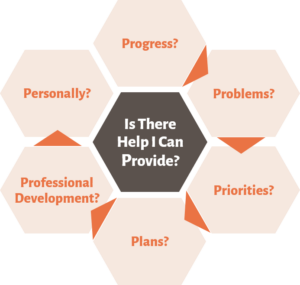 Treat these check-ins as opportunities to ask and listen more than tell, to have a conversation rather than make a speech. Structure them around a consistent set of questions to draw out information you need to help each team member stay engaged and productive, questions like...
Treat these check-ins as opportunities to ask and listen more than tell, to have a conversation rather than make a speech. Structure them around a consistent set of questions to draw out information you need to help each team member stay engaged and productive, questions like...
- What Progress have you made on your work assignments since we last talked?
- What Problems have you had to solve?
- How clear are you regarding your Priorities for action going forward?
- How confident are you that our Plans are achievable?
- Is there any help I can Provide right now?
- Have you had sufficient opportunity to work on your Professional Development?
- How are you doing Personally?
These meetings may seem like overkill and some team members will resist. But be careful. What you need to hear in these meetings is unlikely to be exposed in a full team meeting or come up in phone call about pressing tactical issues. It’s too personal, for your ears only, and shared only when they genuinely believe you are listening. When someone says, "Everything's fine", that's often not the whole story. Few of us enjoy seeming weak or needy. Be ready with questions to uncover the unique issues remote workers can be dealing with, questions like...
- "What's the best/worst part of working from home?"
- "Do you feel included in team decisions?"
- "Which of your co-workers would you like to spend more time with?"
Finally, take some time, even a few moments, just before a check-in meeting to get your head in the right space and focused on the individual you will meet. If you are distracted by something that happened before the meeting or what may happen after, they will know. True leadership mostly happens in conversations with followers. Be sure you are fully present and prepared when you speak with them.
Here's an example of an on-line tool you might find helpful for regular, scheduled check-ins. Ask me how you can use it.
(Note: When challenged enter these credentials exactly as shown: Team Name = "TeamName", Email = "Password")
If you have information team members simply need to know, spare them a meeting, and communicate it via email. But if you expect more of them - acceptance, support, ideas, change - create a bigger opportunity for team members to converse with you and each other, a chance to inquire, exchange, explain, problem-solve, and create together.
For simple conversations that can be completed in one sitting, meeting via phone call, live chat, or video conference may be the right choice. Be aware though that the most common complaint of remote workers regards the amount of time they are asked to spend in meetings. Use their time well by ensuring every meeting has the right...
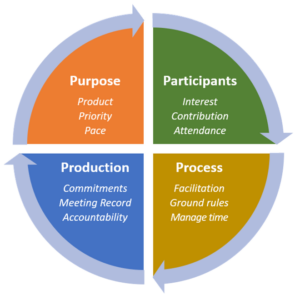 Purpose - Set an agenda, preferably before the meeting but even at the beginning of the meeting (take 3 minutes). A quality agenda should clarify...
Purpose - Set an agenda, preferably before the meeting but even at the beginning of the meeting (take 3 minutes). A quality agenda should clarify...
- Products - the specific goal or deliverable expected from each agenda item.
- Priority - agenda items ordered from most important to least.
- Pace - enough time allowed to engage with each agenda item.
Participants - Invite only those who have interest and something to contribute to the agenda items, or allow those not involved in an agenda item to escape appropriately. Commonly used communication technologies have features like recording and transcript production so anyone who simply needs to know what happened in a meeting can know without being there.
Process - Facilitate involvement of all participants, inviting contributions from quiet team members, intervening when ground rules are broken, negotiating conflict, etc. Manage to the time allotments set in the agenda but be flexible enough to extend time if the group agrees it is productive.
Production - Record who will do what by when for any commitments made, then review these at the end of the meeting. Capture commitments and key conversation points in minutes to be shared with all who have an interest in the meeting content. And be sure to follow-up on these commitments, holding all accountable for their promises.
Real-time meetings are efficient and comfortable. But some team members need more time than others to decide what they think or share what they have to offer. Especially in video conferences, even usually outgoing individuals can be reluctant to speak up. Follow up with quieter participants after a virtual meeting to be sure their valuable input was heard, and they didn't feel bulldozed.
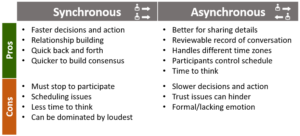 For more complex discussions and where time allows, consider asynchronous connection methods as an alternative to adding another meeting to everyone's already busy schedule. Modern chat tools allow conversations to proceed at the convenience of those involved, interacting without the requirement to respond immediately to every input. Team members have time to organize their thoughts, can contribute when they have time, and are free to work on other things between contributions. Discussion can continue until all have been heard and issues have been resolved, rather than being cut off artificially by the scheduled end of a real-time meeting.
For more complex discussions and where time allows, consider asynchronous connection methods as an alternative to adding another meeting to everyone's already busy schedule. Modern chat tools allow conversations to proceed at the convenience of those involved, interacting without the requirement to respond immediately to every input. Team members have time to organize their thoughts, can contribute when they have time, and are free to work on other things between contributions. Discussion can continue until all have been heard and issues have been resolved, rather than being cut off artificially by the scheduled end of a real-time meeting.
Finally, in team meetings and one-on-ones, regularly set aside some time for informal conversation. Use that time to re-connect on a personal level and catch up on all the "little things" remote workers miss that would naturally spread in an on-site team over coffee or during the chit-chat that happens before a face to face meeting gets started. Hearing about happenings in the company or personal events solidifies relationships and reminds everyone that they are part of something bigger than what's happening in their home office.
It is easy feel a little lost on the job today. Work is less concrete, more complex, and requires more connections with others than in the past. There are more options and possibilities to choose from, more people who have an opinion, most with high and sometimes conflicting expectations.
Questions about what to do and why it's being done are ever-present. And without ready access to leadership or co-workers who may have the answers, remote workers can easily...
- Lose Direction - working without the perspective, priorities, or plans they need to see where they are going;
- Lack Discipline - straying from the high value contributions they should make toward lower value activities that waste their time, talent, and energy.
Some will just put their head down, butt up, and work hard. It feels good, at least for a while. But hard work alone is not enough to succeed in today's business environment. People will be busy, but too few of the right things will get done. Team members will also work at cross purposes, creating conflict that further disrupts their efforts. Disengagement and performance problems will soon follow.
With the team and individual members, define longer-term (90 day) goals to sharpen their focus and create opportunities for collective effort. Draw attention especially to critical maintenance, improvement, or team development objectives that tend to get lost in the pressures of day to day demands. For each goal, negotiate a "Promise to Perform", an agreement that answers four important questions...
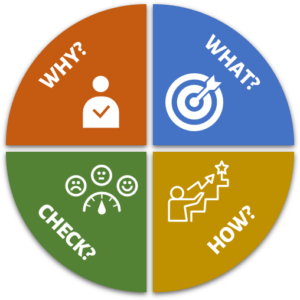 What will we accomplish together? Describe the results, outcomes or conditions—the end you have in mind—that will exist if the work is successful, Be specific. Set stretch goals, asking “What’s really possible?” rather than “What’s predictable?”, or “What have we done before?”
What will we accomplish together? Describe the results, outcomes or conditions—the end you have in mind—that will exist if the work is successful, Be specific. Set stretch goals, asking “What’s really possible?” rather than “What’s predictable?”, or “What have we done before?”
Why does it matter? Work isn't meaningful without context. Remote workers often don't have the background or context that led to major decisions or strategy, putting them at risk of feeling left out or forgotten. Create a line of sight for them from the work to be done to the larger purpose, strategies, goals, and activities of the team or organization. Clarify what's at stake, and the consequences of inaction or failure. And make sure to touch each performer’s engagement hot buttons, answering their often unasked but always present question, “What’s in it for me?”
How will we do it? Ask all involved, “What’s missing to get us from where we are now to the outcome we envision?” Steps will have to be taken and best practices applied. Resources and appropriate decision-making authority must be in place to inspire confidence the work is doable, the outcome achievable. Anticipate potential breakdowns and put contingency plans in place to mitigate the risk they will happen and impact if they do.
How will we Check progress? If you can’t measure it, then it is just a good intention, not a true goal. Identify metrics to assess the quantity and quality of deliverables, and milestones to ensure timely delivery. Have the team “keep score” where possible so they can evaluate their own performance without your intervention. Success and momentum sustain commitment to a task. And if they know when they are off track, responsible individuals will make their own correction, saving you the need to intervene.
Here's a downloadable Performance Promise Worksheet to help.
Leaders face growing pressure to get more from the assets available to them, including their most important assets—people. For some the solution is to control, incent, or coerce employees to get more from them. While these strategies may seem to work short-term, they prove unreliable over time for people doing all but the most routine, simple tasks.
If you have hired correctly, the people you work with have a desire to perform well, to succeed. They take satisfaction from doing their best work. Rather than having to be pushed and prodded into action, they can be motivated internally to achieve results with you as they pursue their own set of workplace needs.
Empowering leaders oblige these good people to take a larger role in their work, offering them opportunities to have input and make choices about the tasks they take on, how they do them, who they work with, etc.. That freedom provokes a performer’s natural desire for autonomy and achievement, so they are more likely to contribute to their full potential.
Empowerment is often misunderstood. Many leaders believe empowerment is simply about giving performers power. But they already have power in their expertise, experience, and energy. And in today’s workplace, especially with a remote team, you are largely unable to closely supervise their work. Your role is less about giving performers power than making sure they are free to use the power they already have responsibly.
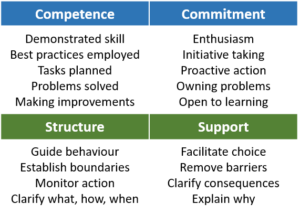 Many performers think empowerment means they have free rein to make all decisions in their work. They miss that the price of freedom is responsibility to perform to their ability, to work well with others, and to account for their choices and actions. No one at work can just “go it alone”, doing whatever they want.
Many performers think empowerment means they have free rein to make all decisions in their work. They miss that the price of freedom is responsibility to perform to their ability, to work well with others, and to account for their choices and actions. No one at work can just “go it alone”, doing whatever they want.
Free your team of unnecessary supervision and controls, creating space for them to use their own wisdom and talent when they demonstrate capability to take on the tasks t hand. It would be irresponsible for you to turn work over to anyone unable or unwilling to do it as well as it needs to be done. But don't make yourself an unnecessary barrier between capable performers and their work. If you do, you will end up busy doing their jobs, while they sit on the sidelines under-challenged and frustrated.
Assess Task-Specific Capability
 Capability is: “Recurring/reproducible behaviour that generates worthwhile outcomes.”
Capability is: “Recurring/reproducible behaviour that generates worthwhile outcomes.”
Capability = Competence + Commitment. Capable performers are able and willing, skilled and confident. Competence and commitment are independent variables. A performer can be unmotivated but skilled, or willing but without ability. Assessing these parts of capability separately helps you diagnose performance issues and know better who is ready for empowerment.
Capability is task specific. People are not capable or incapable as a whole. While we often categorize performers this way, more careful assessment reveals most are capable in some areas, but not in others. Even poor performers do some things well and should be freed to do those parts of their job. And every high performer has areas of work where they are less skillful or willing, tasks where they could use a little guidance and support.
To assess their capability, focus on behaviour related to a specific task. This minimizes the risk your assessment is influenced by history, emotion, or hearsay. An objective assessment is the goal.
Flex Your Coaching Tactics
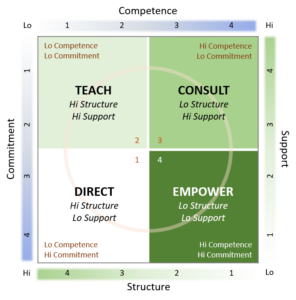 Coaching is comprised of two types of behaviour…
Coaching is comprised of two types of behaviour…
- Structure—task oriented; you direct or control what will be done, when, how, and by whom.
- Support—relationship oriented; you have conversations or take action taken to enhance confidence and commitment.
These behaviours are independent. How much you do of one is not affected by how much you do of the other.
Match your coaching to the capability you observe. As you work with a performer on a task, use the combination of these behaviours best suited to the capability assessed for that task. Where they lack competence, add structure. Support their efforts where you see low levels of commitment.
In practice, you can adjust your coaching behaviour even during a conversation. Some worry this will seem inconsistent, that you are treating people differently. In fact, your goal is absolute consistency—in the same situation, with the same capability, you use the same tactic, every time.
Adjust as You Go
What you see now is not necessarily what you could eventually get. Too often we fall into resignation about performance, accepting the behaviour we see now as all there is to get. When you expect too little, you can become a drag a performer’s growth, your low expectations a self-fulfilling prophecy. When you ignore problems because a performer has been a “high” performer, you risk letting those problems grow, not offering the help needed while others wonder why you haven't intervened.
Adjust your coaching gradually to draw a developing performer toward full empowerment. For example, if you are “Teaching” (Hi Structure/Hi Support), reduce direction while you sustain support. Essentially, take a risk by providing less task help while making yourself available to facilitate problem solving or to bolster confidence.
There is no rule for how long it takes to get to full empowerment. Focus on your target, take reasonable steps, and you will succeed. You may be tempted to short circuit this gradual progression by jumping levels, going directly from Teaching to Empowering for example. Seems efficient, but it seldom works. It takes time for new skills to become habits and confidence to become sufficient for the move from dependence to independence on the job.
Don’t Be Surprised by Occasional Setbacks
Performers do regress. You may see performance declining from time to time as circumstances change. Competence can be diminished by lack of use, new challenges in the work, or changes in technology. Commitment can deteriorate due to distraction or weakening satisfaction with their work or workplace.
Adjust your coaching tactics back. If you observe concerning changes in task-specific behaviour, add support or structure to align with the new level of capability. The most common mistake made in these regression situations is continuing to assess high capability despite evidence to the contrary. You are not doing anyone a favour by sticking with a tactic that is not working, acting on the basis of history rather than adjusting to what you can see happening right now.
Here's a downloadable Empower Capability Worksheet to help you apply this tip.
The link between performer and work has traditionally been seen as rational and transactional; people work for a pay cheque. In this view, performance is driven extrinsically, by pursuit of reward, required adherence to rules, or fear of punishment. A supervisor then…
- Incents—connecting rewards with the work to be done.
- Controls—bounding the work with directives and policies so it is done as asked and expected.
- Coerces—threatening sanctions if work is not done as asked.
 This “carrot and stick” strategy of motivation (Theory “X”) is a simple formula that says: “If you do this, then you will get that.” It works well in jobs that are routine, with simple steps, few options, and a short time horizon. But it doesn’t suit today’s work or workers.
This “carrot and stick” strategy of motivation (Theory “X”) is a simple formula that says: “If you do this, then you will get that.” It works well in jobs that are routine, with simple steps, few options, and a short time horizon. But it doesn’t suit today’s work or workers.
Coercive, heavy handed tactics might get things done short-term, but don't nurture a sense of responsibility and stoke a performer’s fire for the long haul. Rely on this approach too much and you constantly need bigger, better carrots and sticks to drive effort. Or if the drivers are removed, you can watch effort deteriorate.
 Research and simple observation suggest people want more from their work than money. Their motivation can come from internal sources, needs and wants that all of us have. In the right conditions, work itself can draw out best efforts, providing a payback that goes far beyond a paycheque. When that second, personal cheque is paid, your team's heart and head are engaged along with their hands. And it is paid without need for constant intervention by a third party—you.
Research and simple observation suggest people want more from their work than money. Their motivation can come from internal sources, needs and wants that all of us have. In the right conditions, work itself can draw out best efforts, providing a payback that goes far beyond a paycheque. When that second, personal cheque is paid, your team's heart and head are engaged along with their hands. And it is paid without need for constant intervention by a third party—you.
These intrinsic needs go by many names and look different depending on the individual expressing them. But there is a common, predictable pattern that has emerged.
![]() Significance - We all need to feel unique, special in some way. When employees see themselves treated as generic, anonymous, or irrelevant, mere commodities on the job, they won’t be engaged. A sense of significance is personal, arising from self-esteem. However, every employee appreciates when others take time to get to know them, understand their needs and wants, and respect what they bring to their work. Asking for their opinion, acting on their ideas, and recognizing their contributions furthers their sense that they matter, and their efforts are valued.
Significance - We all need to feel unique, special in some way. When employees see themselves treated as generic, anonymous, or irrelevant, mere commodities on the job, they won’t be engaged. A sense of significance is personal, arising from self-esteem. However, every employee appreciates when others take time to get to know them, understand their needs and wants, and respect what they bring to their work. Asking for their opinion, acting on their ideas, and recognizing their contributions furthers their sense that they matter, and their efforts are valued.
![]() Connection - The need for connection is core to the human condition. We are hard-wired to seek out belonging, to be amongst friends, to feel the protection and support of allies. When the social environment feels unsafe, anxiety, risk avoidance, and uncooperative reactions are triggered, often resulting in toxic behaviours like backbiting, cynicism, gossiping, cliques, and silo thinking. When employees have an opportunity to be part of a team where they experience warm interpersonal relations, approval, and occasionally a little fun, their attention and energy is freed up to pursue other needs.
Connection - The need for connection is core to the human condition. We are hard-wired to seek out belonging, to be amongst friends, to feel the protection and support of allies. When the social environment feels unsafe, anxiety, risk avoidance, and uncooperative reactions are triggered, often resulting in toxic behaviours like backbiting, cynicism, gossiping, cliques, and silo thinking. When employees have an opportunity to be part of a team where they experience warm interpersonal relations, approval, and occasionally a little fun, their attention and energy is freed up to pursue other needs.
![]()
Mastery - Mastery is the need to attain a standard of excellence, to increase knowledge, skills, and performance in something that matters to the employee. Those motivated by mastery want to be better. If work assignments don’t challenge them to improve and grow, they become bored, feeling stagnant or stuck. Interest and energy will wane. Engagement is enhanced when work assignments pique an employee’s interest, stretch their capability appropriately, and offer the space and support needed to learn. When this need is tapped expect an employee to become focused and persistent in their efforts, seeking out even further challenge when their development goals have been reached.
![]() Autonomy - Autonomy is the need to direct one’s own life. Employees expressing this need at work seek to control what they do, when, how, and who they work with as much as possible. They feel stifled by strict workplace rules and intrusive supervision. Tapping this need does not require letting employees do whatever they like – that’s anarchy, not autonomy. Instead, align work assignments with an employee’s interests, negotiate goals and standards with them, define boundaries on decision-making that suit their demonstrated capability, then free them to work within those limits. When mistakes or breakdowns inevitably happen, respond with patience and coaching rather than criticism and punishment. Fear drives action but in unpredictable and mostly unhelpful directions.
Autonomy - Autonomy is the need to direct one’s own life. Employees expressing this need at work seek to control what they do, when, how, and who they work with as much as possible. They feel stifled by strict workplace rules and intrusive supervision. Tapping this need does not require letting employees do whatever they like – that’s anarchy, not autonomy. Instead, align work assignments with an employee’s interests, negotiate goals and standards with them, define boundaries on decision-making that suit their demonstrated capability, then free them to work within those limits. When mistakes or breakdowns inevitably happen, respond with patience and coaching rather than criticism and punishment. Fear drives action but in unpredictable and mostly unhelpful directions.
![]() Achievement - Those motivated by this need seek to excel and maintain lofty standards even if that involves difficulty, prolonged effort, and risk. Employees with a high need for achievement appreciate new, challenging tasks with specific goals they feel are reasonable. If they feel an assignment is too hard, anxiety and frustration diminish their performance. The ideal work assignment finds an energizing balance that pushes an employee out of their “comfort zone” but not into their “panic zone”. Need for achievement is best fed when employees can gauge their progress and level of contribution for themselves, independent of the opinions or whims of another person, no matter how well intended that person may be.
Achievement - Those motivated by this need seek to excel and maintain lofty standards even if that involves difficulty, prolonged effort, and risk. Employees with a high need for achievement appreciate new, challenging tasks with specific goals they feel are reasonable. If they feel an assignment is too hard, anxiety and frustration diminish their performance. The ideal work assignment finds an energizing balance that pushes an employee out of their “comfort zone” but not into their “panic zone”. Need for achievement is best fed when employees can gauge their progress and level of contribution for themselves, independent of the opinions or whims of another person, no matter how well intended that person may be.
![]()
Purpose - Even the most cynical employees need to know that their work matters to someone, anyone. It is perhaps the most overlooked need at work. Employees with high need in this area care more about giving than getting, as much about contributing to a greater good as receiving a pay cheque. When they don’t see a connection between their efforts and a meaningful outcome, these employees simply will not find lasting fulfillment in their work. Help them have a line of sight from their tasks to a compelling mission, then ensure that wherever they look in the organization they see actions and decisions aligned with that mission.
One more thing you should know: for your followers, you are the most influential person in their work lives. You have more potential to impact their work and influence their engagement than anyone else, for good and bad. When you invest in their needs, they notice.
Every week make a regular habit of building a list of leadership actions you can and should take to engage the members of your remote team. Set aside just 5 or 10 minutes to think about them, what's going on in their work, and what you can do to bolster their motivation by attending to their intrinsic needs. Make a list, then during the week check each action off as you do them.
This downloadable Deliver the Second Pay Cheque Worksheet will help you employ this habit.
Leading isn't about checking to see if people are working. It's about creating the conditions in which they can do their best work. It's easy enough though to get wrapped up in the tactical/technical demands in your day and never ask, "How are you doing?"
Ask team members this question regularly, then listen for what's getting in their way. Even seemingly small problems or “hassles” can create distraction or distress that erode focus and energy. And remote workers can experience more than their share of these hassles, everything from poor WIFI connections, to equipment that doesn't work, a co-worker who doesn't respond, or interruptions at home.
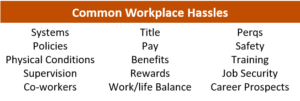 Start a “Hassle List", recording the concerns and complaints raised by your team. When performers see that you are serious about working on their hassles, you may find the list they bring forward becomes overwhelming. You need a systematic approach to ensure the return you get is worth the effort you put in. Try these steps...
Start a “Hassle List", recording the concerns and complaints raised by your team. When performers see that you are serious about working on their hassles, you may find the list they bring forward becomes overwhelming. You need a systematic approach to ensure the return you get is worth the effort you put in. Try these steps...
1) Ask everyone - Of course you want to hear what high performers say. But lower performers can offer a different and useful perspective and may be more willing to speak up about problems everyone is having.
2) Make a list - Don’t leave anything out. Ignoring a hassle raised sends the wrong message. And, what you think trivial may be the tip of a bigger issue, or one that really matters to others. Carefully combine similar issues with input from the team.
3) Prioritize the list - You can’t do everything. Fortunately, you don’t have to. Even your harshest critic will recognize you have limitations and taking on a critical few will make the biggest difference. Work with the team to identify the hassles that have the greatest impact on their work and are worth most to them or the organization.
4) Act on the priorities - Commit to doing what you can about the top 2 or 3 hassles, then do it. Work with the right people, gather the data you need, look for the cause, identify helpful ideas, then implement those most likely to help.
5) Report progress - If performers don’t see anything happening, they’ll assume you are doing nothing. Close the loop with them, explaining progress you're making and what’s been resolved. If there is nothing you can do, tell them that. They may not like what they hear, but at least they’ll understand, and more than likely respect your honesty.
Good work appreciated is more likely to be sustained. When you share the same workspace, it's relatively easy to see when a little recognition or reinforcement is needed, then offer it. Yet surveys reveal more frequent, honest feedback consistently tops the list of what employees want on the job. Remote workers are even more prone than their on-site peers to feeling forgotten and under-appreciated.
You have the power to help remote team members see value in themselves and their work, while highlighting the behaviours, work methods, or achievements that create value for the business. Reinforcement doesn’t have to be complicated or expensive. The most impactful way to communicate you care is in feedback conversations where you help them see their performance as you see it and clarify why it matters.
Don’t confuse feedback with paperwork. Filling out a form every few months is not feedback. Every individual is different, some needing more recognition and reinforcement to sustain their performance than others. But all need more than they get from the routine, box-filling exercises mandated by most organizations.
Every day someone will accomplish something, behave effectively, or demonstrate a worthwhile characteristic. Let them know you notice.
Lay a solid foundation - You can find lots of tips and tricks for giving feedback. Ultimately though the effectiveness of any feedback conversation, reinforcing or corrective, depends much more on two things you can work on with your team before the conversation happens...
- Clarity of expectations - the effort you put in with performers when a task or project is assigned to ensure they understand what's expected, why it matters, how it should get done, and how their performance will be checked.
- Quality of relationship - their sense that you respect who they are, trust in them and can be trusted, and have their best interests in mind.
Schedule regular status updates - Never assign a significant task or project without making a plan to check progress regularly and at critical milestones. For routine tasks, set up logs to track the work, providing you and the performer something concrete to review and discuss. Put reminders in your calendar so you don't forget these follow-up conversations.
Observe carefully and objectively - Take advantage of whatever opportunities you have to “catch” your team doing the right things while they work. Be wary of natural human biases toward looking only where we expect problems and noticing the bad more easily than we notice the good. Invest time and attention each week to review what's happening with respect to critical projects and tasks, or team member behaviour, noting...
- Exceptions - actions, results or progress significantly above or below expected.
- Improvements - meaningful change in a positive direction.
- Maintenance opportunities - good, solid work that needs to continue.
Schedule time for feedback - When you see the right things happening, speak up right away or make a note to follow up later. Schedule those delayed follow-ups right away so you don't forget, then manage these commitments as you would any other.
 Reinforce strong performance specifically - A casual, “Atta boy!” or “Good job!” is not much better than saying nothing. The more specific the reinforcement, the more powerful the impact. Prepare to share details of…
Reinforce strong performance specifically - A casual, “Atta boy!” or “Good job!” is not much better than saying nothing. The more specific the reinforcement, the more powerful the impact. Prepare to share details of…
- Situation—the context for your observation, what was happening.
- Observation—what you saw and want to see more, their behaviour or actions deserving of recognition.
- Impact—the effect or consequence of what you saw, what happened next and why it matters to them, you, others, or the bigger results you seek together.
Have a conversation for action - Get them involved, giving performers a chance to tell you what happened in their eyes. Then, develop a plan to move forward together, building on or extending their good work. When you put in the work to appreciate their efforts and accomplishments, performers are more open to your coaching and may be ready take on new, difficult, or risky next steps.
Here's a downloadable Make Performing Matter Worksheet you may find helpful.
Performance breakdowns happen despite everyone's best efforts. Leader and performer share responsibility for making these problems right. Challenging team members to step up responsibly to address breakdowns in their performance is a necessary part of leading any team.
Most leaders struggle in those situations, unsure how to say what needs to be said, worried they might provoke a negative response. That struggle is only complicated when your connection with your team is at a distance, via phone or video conference.
Here's the truth though: people always respond negatively to unwelcome news and criticism. None of us enjoy hearing either. It makes us uncomfortable at best, defensive and angry at worst. Your job is not to keep the people you work with, or yourself, comfortable. They can't be allowed to hide their problems; you can't avoid these conversations. Things don't change when everyone feels comfortable. You must deliver the tough messages, and you can't control how they react.
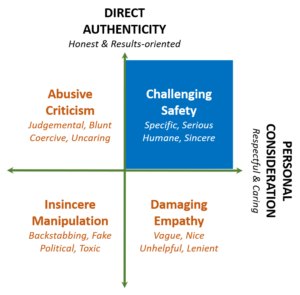 The remedy is direct authenticity, tempered with personal consideration for your performance partner(s). Straying from the truth as you see it muddles the message, putting results at risk. Disrespect provokes defensiveness and damages relationships. Help them feel “challenged but safe”, nurturing the right conditions and conducting these responsibility conversations in a thoughtful, organized way.
The remedy is direct authenticity, tempered with personal consideration for your performance partner(s). Straying from the truth as you see it muddles the message, putting results at risk. Disrespect provokes defensiveness and damages relationships. Help them feel “challenged but safe”, nurturing the right conditions and conducting these responsibility conversations in a thoughtful, organized way.
Assume good intentions, not malice - Any of us can also fall victim to a primal human defense mechanism that predisposes us to assume malice or threat in the behaviour of others when inattention or incompetence just as easily explains their perceived poor behaviour. Absent direct evidence to the contrary, start from an assumption of positive intent on the part of performers, that they wanted to do the right things, but it didn't work out.
Seek solutions, not blame - It’s not what happened that matters—it’s what those responsible do about it. Disappointment and frustration on your part can easily turn into blaming or punishing others. Feels good short-term, but things get worse. Choose to respond constructively, hard on the problem, not the performer. Ensure problems attract help and support rather than judgement and punishment. Tell the truth, ask tough questions, challenge them, but do it to move forward together, not back toward a scapegoat.
Facilitate choice, not compliance - Trying to control “how” things get done damages responsibility. And “how” isn’t your job - that’s what performers do. Control them and they will simply “do their job”, complying, ready to blame process, other people, even you, for what goes wrong. Give people choices to build commitment and ownership. It's harder to escape responsibility when the choices made are your own.
Expect progress, not perfection - It would be perfect if everyone bought into plans and every plan was flawless. Perfect, but unlikely. Progress creates experience, experience facilitates learning, learning grows capability, and capability drives for success. A single conversation about a performance breakdown is seldom enough. Expect and accept that things won't always go as hoped check-in regularly to review progress, offer support, then adjust plans accordingly.
Your responsibility conversations will go better, and you'll feel more confident, when you are well prepared with a plan to get your message out clearly and engage others productively. Here are four steps to get yourself ready.
1) Clarify the gap - There are 3 types of performance breakdown: attendance, conduct, and production. Focus on one at a time. A performance gap is the difference between what was expected and what happened. The gap is not a description of cause (“You have no talent.”), a solution (“You need training.”), or a judgement (“You are bad.”). To clarify a performance gap...
- Separate facts and your observations from your opinions, assumptions or beliefs.
- Describe “actual” performance you observed: When this happened...Then…
- Flip your description actual performance into a description of what you “expect”: When this happens...I expect…
2) Identify the impact or consequence of the gap - Describe why the gap matters, answering the question, “So what?” ...
- Looking back at what happened, describe the negative impact or consequence of their actions or inaction.
- Looking forward, clarifying the desired impact of the expected behaviour, including value or benefit to the performer.
3) Before going further with your preparation - Decide whether it is worth the effort it will take to change what’s happening. There are potential costs and risks to the team and business depending on the issues you are addressing. Sometimes the best road to change is around a problem, rather than through it. Depending on the seriousness of the situation, you may also need or want to...
- Inform your boss - It is seldom wise to surprise them.
- Check your authority - There may be organizational policies that apply.
- Inform/involve Human Resources - They have expertise to share and may have to be involved if progressive discipline becomes necessary.
4) Prepare to fulfill your responsibilities - You share responsibility for performance with the performer and have a role in improvement. Before speaking with them, consider what you should have “in your back pocket” to offer as structure or support for their change efforts with respect to...
- Clarity - Do they know what is expected?
- Capacity - Are there obstacles to performing?
- Competence - If their life depended on it could they do the work?
- Commitment—Are they confident; rewarded or punished; doing work that matters; engaged?
5) Schedule a meeting - At a time convenient for both of you, in a place where you can talk privately.
6) Start the conversation constructively - Describe your positive intent in just 1-2 sentences, for example: “I want to discuss ... And how we work together to…”
7) Share your observations/expectations - Share what you observed, the “actual” performance and impact, adding just enough details for clarity. Then turn your focus to the future, briefly describing what you expect and why.
8) Ask an engaging question - Allow them a chance to share their perspective, perhaps: “Tell me what you saw happening?” Then listen carefully, seeking to clarify what they saw or may have been missing that contributed to the breakdown.
9) Help them fulfill their responsibilities - They have a choice to make - to close the gap, moving forward with you, or not. Help them make that choice by problem solving together, asking, “How can I help get things back on track?” Offer structure where their competence is lacking, and support where they lack confidence or commitment. Counter excuses and blame with a question: “What can we do about that?”
Here's a downloadable Hold Everyone Response-Able Worksheet to help you get ready.
One of the most important things you can do for any team is to understand the ambitions of each team member, and how their current job fits into their career plans. Remote workers have goals and aspirations just like on-site staff, but often find it much harder to see a path toward them from their home office. It may not come up in day to day conversation, but they are likely considering their options and need your help.
1) Start with the past - Get their life story, listening for what has driven their choices along the way. What do these choices reveal about what they love and hate in their work, what they truly value and what motivates their best efforts?
2) Talk about the future - Ask where they want to be "when they grow up", what their aspirations are for their career. Everyone has dreams but may need help making them a little more tangible.
3) Share the context - Clarify the needs and opportunities available in your team, and in the organization. Be honest with them. The reality is some may have to leave to get where they want to go, but best they and you know that so you both have time to prepare.
4) Plan for the present - Work together to build an action plan for their development, with next steps, timelines, and clear descriptions of the support you can provide.
5) Execute the plan - Your involvement could be direct, perhaps providing some training, facilitating access to courses and resources, or making introductions to expand their network. Some would be happy enough to have you simply checking on their progress regularly, becoming an accountability partner to keep them on track
Working with team members to clarify their career path and development plan shows you care about them and the team in a very tangible way. It might also save you from an unpleasant surprise when someone you are counting on decides to take their talent and potential elsewhere, leaving your team for what they think is a better opportunity somewhere else.
What's working for you?
What are you seeing in your remote team? What practices and tactics for working with them are working for you? Feel free to share your thoughts below or get in touch to discuss your experience and these tips.
Leadership Anchors
 In climbing, the “lead” is first up, setting the path or route. Along the way, the lead places “anchors”, points of attachment to provide “protection” for themself and others who follow, freeing all to use their talents confidently and competently.
In climbing, the “lead” is first up, setting the path or route. Along the way, the lead places “anchors”, points of attachment to provide “protection” for themself and others who follow, freeing all to use their talents confidently and competently.
Our Leadership Anchors are habits and hacks for leading. With the right anchors in place and used well, you will be better able to apply your unique strengths and style to the challenge of delivering results by leading others.
Ask us how our coaching can help you function as a better leader, on the job, where it matters.
Have Questions?
Use the Comment section at the bottom of this page or Contact Us for more information.
